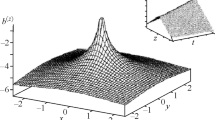Abstract
Experiments have shown the strong rotation in plastic deformation, which is caused by the disclination, specific arrangement of dislocation and inhomogeneity of the gliding motion of the defects in the microscopic scale. Based on the microscopic mechanism of the rotational plastic deformation, the conservation equation satisfied by the defects motion (dislocation and disclination) has been developed in this paper. Then the diffusion motion of the defects are reduced based on the asymmetric theory of continuum mechanics. By utilizing the maximization procedure for the micro plastic work and a scale-invariance argument, various models of Cosserat-type plasticity are obtained in this manner.
Similar content being viewed by others
References
E. C. Aifantis, Physics of plastic deformation,Int. J. Plasticity,3 (1987), 211–247.
E. C. Aifantis, On the dynamical origin of dislocation patterns,Mater. Sci. Eng.,81 (1986), 563–575.
R. Dewit, A view of the relation between the continuum theory of lattice defects and noneuclidean geometry in the linear approximation,Int. J. Engng. Sci.,19 (1981), 1475–1506.
J. P. Nowacki, Theory of disclination in elastic cosserat media,Arch. Mech.,29 (1977). 531–545.
M. Kleman, The general theory of disclinations,Dislocation in Solids, (ed. by F. R. N. Nabaroo,) North-Holland Publishing Company,5 (1980), 243–297.
Shun-ichi Amari, Dualistic theory of non-riemannian material manifolds,Int. J. Engng. Sci.,19 (1981), 1581–1584.
M. J. Marcinkowski, Dislocations and disclinations in a new light,Arch. Mech.,42 (1977), 279–289.
M. J. Marcinkowski, The differential geometry of disclinations; wedge dislocations,Arch. Mech.,29 (1977), 313–324.
V. I. Vladimirov, A. A. Kusov, et al., Rotational model in slip channels without dislocations,Phys. Met. Metall.,68, 26–31.
E. C. Airantis and A. Ye. Romanov, Reaction-diffusion scheme for dislocationdisclination ensembles.
H. Lippmann, Eine cosserat-theorie des plastischen fliebens,Acta Mechanica,8 (1969), 255–267.
Z. Olesiak and M. Wagrowska, On shear and rotational yield conditions,Arch. Mech.,37 (1985), 147–155.
I. Vardoulakis, Shear-banding and liquefaction in granular materials on the basis of a cosserat continuum theory,Ingenieur-Archiv,59 (1989), 106–113.
H. B. Muhlhaus and I. Vardoulakis, The thickness of shear bands in granular materials,Geotechnique,37 (1987), 271–283.
D. Besdo, Ein Beitrag zur nichtlinearan theorie des Cosserat-Kontinuums,Acta Mechanica,20 (1974), 105–116.
Author information
Authors and Affiliations
Additional information
Communicated by Yang Gui-tong
Rights and permissions
About this article
Cite this article
Jian, G., Xiao-ling, L. A Physical theory of asymmetric plasticity. Appl Math Mech 16, 493–506 (1995). https://doi.org/10.1007/BF02459348
Received:
Issue Date:
DOI: https://doi.org/10.1007/BF02459348



